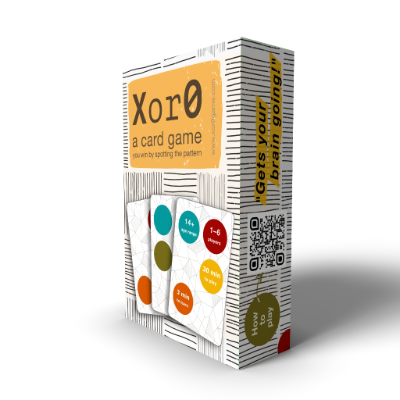Instructions
How to play
Place a shuffled deck on the table face down. Arrange seven cards on the table face up. You can adjust the difficulty by playing with fewer cards. For your first game, we recommend starting with “Easy” or “Medium” so its easier to spot the groups.
A player who finds a XOR0 group announces it by saying: "XORO!" If correct, the player takes the group of cards. If wrong, the player pauses until a correct group is found. The player joins the game again for the next group.
Replenish the table with cards from the deck. The game ends immediately when the last card is drawn.
The player who took the most cards wins. Ties are broken by the number of dots collected.

recognize a Xor0 group
Count dots: Each dot color must exist an even number of times in the group. It can be 2, 4 or 6 times depending on the level of difficulty you are playing.
Spatial thinking: Assume two dots of the same color cancel each other. Look for groups of cards where all dots get canceled.
Arithmetic: For each card, sum up the numbers. Convert to binary. Calculate xor of cards in the group. The result must be zero.
Most players discover their personal strategy after a few rounds of play.
The red dot and the green dot appear 3 times. Either one of these would make this group invalid.
In both examples, each color appears an even number of times (2 or 4 times). If you overlay these cards, all dots would cancel each other out.
Each dot also has a number on it and you can calculate the sum for each card. The 3 card example above can be represented arithmetically, with the same result. XORO!
Adjust the difficulty
Sort out cards with 3,4, or 5 dots to adjust the difficulty and the duration of the game.
Easy
Discard cards with the numbers 32, 16, and 8.
There will be 7 cards left in the deck.
Start with 4 cards on table.
This takes ~1 minute per game
Medium
Discard cards with the numbers 32, and 16.
There will be 15 cards left in the deck,
Start with 5 cards on table.
This take 1-2 minutes per game
Normal
Discard cards with the number 32.
There will be 31 cards left in the deck.
Start with 6 cards on table.
This takes 2-5 minutes per game.
Master
Play with the full deck.
There will be 63 cards left in the deck.
Start with 7 cards on table.
This takes 10-30 minutes per game.
Some examples to practice
All examples are using the full deck. So there are 7 cards on the table. Sometimes there are multiple groups on the table. In that case, go for the one involving the most cards or the most dots. When all cards are played, the player with the most cards wins the game. If there is a draw, the number of dots collected breaks the tie.
Example 1
Start on the left to try and identify the group.
7 cards are face up on the table
Identify a group
Verify that each number/circle appears an even number of times in the group
Collect your cards if it is correct
Example 2
Start on the left to try and identify the group.
There are 2 groups in this set of cards. Can you find the other one?
Hint: it involves 2 dots on 3 cards
Example 3
Start on the left to try and identify the group.
Again, there are 2 groups in this set of cards. Can you find the other one?
Hint: it involves 4 dots on 3 cards.











